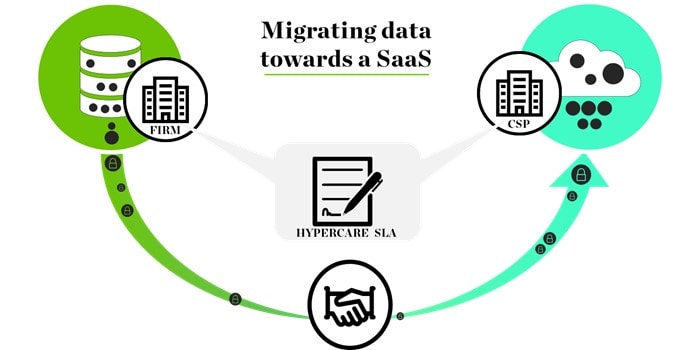Overcoming data migration challenges has been saved

Article
Overcoming data migration challenges
Part 5: A guide through your cloud transition journey
The cloud can be a critical element of an organization’s competitiveness, but the journey to cloud transition is full of technological and strategic challenges. In this blog series, we guide you seamlessly through them. This episode is about migrating data towards a Software as a Service (SaaS) delivery model.
Michiel Peters | August 21, 2019
Go directly to
Migrating your data
If an enterprise replaces its on-premise applications with SaaS applications, it also needs to migrate its most valuable asset—data—to the cloud. Data migration is the process of extracting data from a source system and loading it into a target system. The data migration target system can be hosted either on-premise or in the cloud.
Traditional data migration challenges are also applicable when migrating data to the cloud. So, let’s do a quick recap of the main challenges of migrating data. In this blog on how to make data migration successful, you can read more about those challenges:
- Choosing the right migration tool is important, but it’s just the foundation for successful data migration;
- Ensuring continuous alignment with IT delivery — especially when the target application is being developed simultaneously;
- Ensuring the quality and migration readiness of the to-be-migrated data;
- Continuously managing the migration throughout the organization to retain support and buy-in of stakeholders including senior management, Privacy & Security and IT.
Carefully managing these challenges is critical to successful data migration.

Additional challenges for data migration to the cloud
Additional challenges of migrating data to the cloud arise from two fundamental differences between on-premise and cloud applications:
- IT resources are provided “as a service” instead of purchased as an enterprise product;
- IT resources are requested over the internet as opposed to over an enterprise’s intranet/extranet.
Migrating data without direct control over the target (cloud) environment
The performance of data migrations can traditionally be controlled by managing certain technical variables:
A. Database configurations: e.g. disabling certain indexes or triggers when migrating big batches of data;
B. Server configurations: e.g. temporary additional memory and/or CPU allocation;
C. Presence of (batch) import functionalities;
D. Availability of system instances: e.g. system uptimes and system availability to users.
In the “as a service” cloud model, these technical variables are typically managed by the cloud service provider (CSP). It is important to align technical data migration requirements explicitly upfront with the CSP. For example, if it’s not already available, request a batch import functionality. Leading CSPs generally provide data ingestion tools that cater to uploading significant data volumes to their platforms, so finding the best data ingestion fit is a good criterion to include when selecting the right CSP.
A separate data migration support contract, in addition to the agreed upon SLA, is a good way to arrange the more intensive support needed during the data migration period. A temporary hyper care support model can ensure a quick response time in changing database and/or server configurations according to the needs of the data migration performance. It can also provide monitoring performance and environment stability during the data migration period. Note: the flexibility to change these configurations also depends on whether the SaaS solution is deployed on a dedicated or shared cloud environment.
Ensure data is migrated securely to the cloud
SaaS solutions are typically delivered from a public or hybrid cloud model accessible over the internet as compared to on-premise local networks. Consequently, during a data migration, key business data assets, such as customers, products, orders and billing data, are also transferred over the internet to the cloud, making these data migrations more vulnerable than on-premise data migrations. Added security is important when migrating data to the cloud.
Additional security measures should be incorporated in the data transfer process to address any concerns. In addition to data decryption and encryption, you may want to think about setting up and configuring private network connections and proper authentication and authorization functionalities.
These measures should be included in the upfront data migration requirements with the CSP, as mentioned above. These security measures, however, will affect performance in the data transfer process. To verify that sufficient network and computing performance is available, it is recommended to execute an end-to-end data migration performance test while taking the security measures into consideration.
More challenges?
While traditional data migration challenges remain, migrations to the cloud bring new ones. We’ve addressed those here. Please let us know of other challenges you have faced when migrating data to the cloud. If you have great examples of how you dealt with them, we are interested to learn about those, too. In case you would like to know more about data migration or cloud solutions, please feel free to contact us.
Recommendations
Building what works best
Part 3: A guide through your cloud transition journey
Continuously improving your cloud strategy
Part 4: A guide through your cloud transition journey



